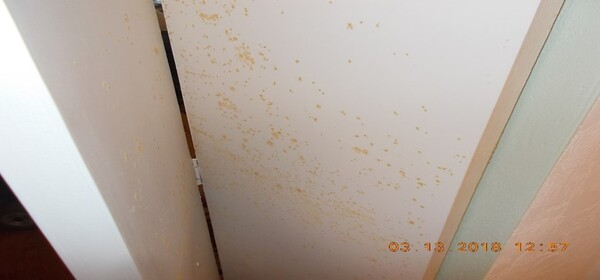
Mold caused by high humidity growing on the backside of closet doors
Florida’s humid climate provides optimal conditions for mold to grow and thrive. Therefore, it is extremely important to maintain the indoor humidity inside your home or workplace below 60% with good air circulation to prevent humidity-driven mold growth.
Many of the building materials inside your home or workplace, such as wood, drywall, and ceiling tiles, provide food for mold to grow. Even dust that has settled on furniture, carpet, or other surfaces is a food source for mold. When you add moisture from high humidity to these food sources that are already inside your home or workplace, mold can start growing and lead to a mold bloom.
Air Conditioner Operation
If your A/C unit is not working properly, or if the A/C thermostat is set too high or turned off altogether, the resulting high humidity can lead to a mold bloom inside your home or workplace. To avoid this, always set the fan mode switch on your A/C thermostat to “auto” (not “manual” or “on”), and set the thermostat temperature no higher than 78°F. When an air handler fan is set on “manual” or “on”, the blower fan does not turn off when the temperature on the thermostat is reached; only the condenser outside turns off. The continuous running of the blower fan tends to pull in outside, humid air that is not being conditioned by the coils of the air handler.
If you live in a condominium unit or townhome that is between other condo units or townhouses, you should closely monitor how often your air conditioner turns on. You may have the thermostat temperature set to 78°F, but because your condo unit or townhome is “insulated” by the adjacent condo units or townhouses, the temperature inside your residence may not exceed 78°F and therefore your A/C unit does not turn on. Since the A/C only removes moisture (humidity) from the indoor air when it is running, you may need to lower your thermostat setting or use a dehumidifier to control the humidity below 60%.
Air Circulation
Maintaining good air circulation is essential to preventing mold inside your home or workplace. Mold spores thrive in stagnant air, and a lack of air circulation will reduce moisture evaporation, further increasing your risk of developing mold. Some quick and easy ways to increase air circulation are:
For more practical mold prevention tips you can start implementing right away, please click here.
If you are concerned about mold in your home or workplace, interested in mold testing, or would like additional information, please contact Chuck at CFL Environmental Solutions. Chuck is a Florida Licensed Mold Inspector and a Certified Indoor Environmentalist, and he would be happy to use his expertise and experience to be of service to you.